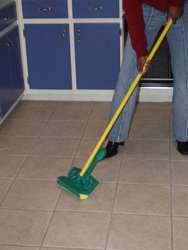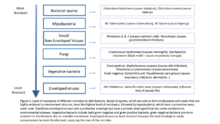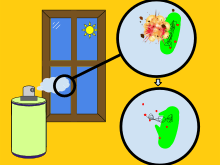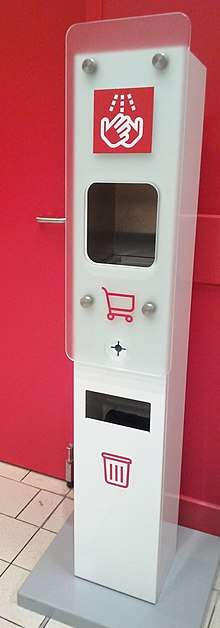Disinfectant
Disinfectants are chemical agents designed to inactivate or destroy microorganisms on inert surfaces.[1] Disinfection does not necessarily kill all microorganisms, especially resistant bacterial spores; it is less effective than sterilization, which is an extreme physical or chemical process that kills all types of life.[1] Disinfectants are generally distinguished from other antimicrobial agents such as antibiotics, which destroy microorganisms within the body, and antiseptics, which destroy microorganisms on living tissue. Disinfectants are also different from biocides — the latter are intended to destroy all forms of life, not just microorganisms. Disinfectants work by destroying the cell wall of microbes or interfering with their metabolism.


Sanitizers are substances that simultaneously clean and disinfect.[2] Disinfectants kill more germs than sanitizers.[3] Disinfectants are frequently used in hospitals, dental surgeries, kitchens, and bathrooms to kill infectious organisms. Sanitizers are mild compared to disinfectants and are used majorly to clean things which are in human contact whereas disinfectants are concentrated and are used to clean surfaces like floors and building premises.
Bacterial endospores are most resistant to disinfectants, but some fungi, viruses and bacteria also possess some resistance.

In wastewater treatment, a disinfection step with chlorine, ultra-violet (UV) radiation or ozonation can be included as tertiary treatment to remove pathogens from wastewater, for example if it is to be discharged to a river or the sea where there body contact immersion recreations is practiced (Europe) or reused to irrigate golf courses (US). An alternative term used in the sanitation sector for disinfection of waste streams, sewage sludge or fecal sludge is sanitisation or sanitization.
Properties
A perfect disinfectant would also offer complete and full microbiological sterilisation, without harming humans and useful form of life, be inexpensive, and noncorrosive. However, most disinfectants are also, by nature, potentially harmful (even toxic) to humans or animals. Most modern household disinfectants contain denatonium, an exceptionally bitter substance added to discourage ingestion, as a safety measure. Those that are used indoors should never be mixed with other cleaning products as chemical reactions can occur.[4] The choice of disinfectant to be used depends on the particular situation. Some disinfectants have a wide spectrum (kill many different types of microorganisms), while others kill a smaller range of disease-causing organisms but are preferred for other properties (they may be non-corrosive, non-toxic, or inexpensive).[5]
There are arguments for creating or maintaining conditions that are not conducive to bacterial survival and multiplication, rather than attempting to kill them with chemicals. Bacteria can increase in number very quickly, which enables them to evolve rapidly. Should some bacteria survive a chemical attack, they give rise to new generations composed completely of bacteria that have resistance to the particular chemical used. Under a sustained chemical attack, the surviving bacteria in successive generations are increasingly resistant to the chemical used, and ultimately the chemical is rendered ineffective. For this reason, some question the wisdom of impregnating cloths, cutting boards and worktops in the home with bactericidal chemicals.
Types
Air disinfectants
Air disinfectants are typically chemical substances capable of disinfecting microorganisms suspended in the air. Disinfectants are generally assumed to be limited to use on surfaces, but that is not the case. In 1928, a study found that airborne microorganisms could be killed using mists of dilute bleach.[6] An air disinfectant must be dispersed either as an aerosol or vapour at a sufficient concentration in the air to cause the number of viable infectious microorganisms to be significantly reduced.
In the 1940s and early 1950s, further studies showed inactivation of diverse bacteria, influenza virus, and Penicillium chrysogenum (previously P. notatum) mold fungus using various glycols, principally propylene glycol and triethylene glycol.[7] In principle, these chemical substances are ideal air disinfectants because they have both high lethality to microorganisms and low mammalian toxicity.[8][9]
Although glycols are effective air disinfectants in controlled laboratory environments, it is more difficult to use them effectively in real-world environments because the disinfection of air is sensitive to continuous action. Continuous action in real-world environments with outside air exchanges at door, HVAC, and window interfaces, and in the presence of materials that adsorb and remove glycols from the air, poses engineering challenges that are not critical for surface disinfection. The engineering challenge associated with creating a sufficient concentration of the glycol vapours in the air have not to date been sufficiently addressed.[10][11]
Alcohols

Alcohol and alcohol plus Quaternary ammonium cation based compounds comprise a class of proven surface sanitizers and disinfectants approved by the EPA and the Centers for Disease Control for use as a hospital grade disinfectant.[12] Alcohols are most effective when combined with distilled water to facilitate diffusion through the cell membrane; 100% alcohol typically denatures only external membrane proteins.[13] A mixture of 70% ethanol or isopropanol diluted in water is effective against a wide spectrum of bacteria, though higher concentrations are often needed to disinfect wet surfaces.[14] Additionally, high-concentration mixtures (such as 80% ethanol + 5% isopropanol) are required to effectively inactivate lipid-enveloped viruses (such as HIV, hepatitis B, and hepatitis C).[13][14][15][15][16]
The efficacy of alcohol is enhanced when in solution with the wetting agent dodecanoic acid (coconut soap). The synergistic effect of 29.4% ethanol with dodecanoic acid is effective against a broad spectrum of bacteria, fungi, and viruses. Further testing is being performed against Clostridium difficile (C.Diff) spores with higher concentrations of ethanol and dodecanoic acid, which proved effective with a contact time of ten minutes.[17]
Aldehydes
Aldehydes, such as formaldehyde and glutaraldehyde, have a wide microbiocidal activity and are sporicidal and fungicidal. They are partly inactivated by organic matter and have slight residual activity.
Some bacteria have developed resistance to glutaraldehyde, and it has been found that glutaraldehyde can cause asthma and other health hazards, hence ortho-phthalaldehyde is replacing glutaraldehyde.
Oxidizing agents
Oxidizing agents act by oxidizing the cell membrane of microorganisms, which results in a loss of structure and leads to cell lysis and death. A large number of disinfectants operate in this way. Chlorine and oxygen are strong oxidizers, so their compounds figure heavily here.
- Electrolyzed water or "Anolyte" is an oxidizing, acidic hypochlorite solution made by electrolysis of sodium chloride into sodium hypochlorite and hypochlorous acid. Anolyte has an oxidation-reduction potential of +600 to +1200 mV and a typical pH range of 3.5––8.5, but the most potent solution is produced at a controlled pH 5.0–6.3 where the predominant oxychlorine species is hypochlorous acid.
- Hydrogen peroxide is used in hospitals to disinfect surfaces and it is used in solution alone or in combination with other chemicals as a high level disinfectant. Hydrogen peroxide is sometimes mixed with colloidal silver. It is often preferred because it causes far fewer allergic reactions than alternative disinfectants. Also used in the food packaging industry to disinfect foil containers. A 3% solution is also used as an antiseptic.
- Hydrogen peroxide vapor is used as a medical sterilant and as room disinfectant. Hydrogen peroxide has the advantage that it decomposes to form oxygen and water thus leaving no long term residues, but hydrogen peroxide as with most other strong oxidants is hazardous, and solutions are a primary irritant. The vapor is hazardous to the respiratory system and eyes and consequently the OSHA permissible exposure limit is 1 ppm (29 CFR 1910.1000 Table Z-1) calculated as an eight-hour time weighted average and the NIOSH immediately dangerous to life and health limit is 75 ppm.[18] Therefore, engineering controls, personal protective equipment, gas monitoring etc. should be employed where high concentrations of hydrogen peroxide are used in the workplace. Vaporized hydrogen peroxide is one of the chemicals approved for decontamination of anthrax spores from contaminated buildings, such as occurred during the 2001 anthrax attacks in the U.S. It has also been shown to be effective in removing exotic animal viruses, such as avian influenza and Newcastle disease from equipment and surfaces.
- The antimicrobial action of hydrogen peroxide can be enhanced by surfactants and organic acids. The resulting chemistry is known as Accelerated Hydrogen Peroxide. A 2% solution, stabilized for extended use, achieves high-level disinfection in 5 minutes, and is suitable for disinfecting medical equipment made from hard plastic, such as in endoscopes.[19] The evidence available suggests that products based on Accelerated Hydrogen Peroxide, apart from being good germicides, are safer for humans and benign to the environment.[20]
- Ozone is a gas used for disinfecting water, laundry, foods, air, and surfaces. It is chemically aggressive and destroys many organic compounds, resulting in rapid decolorization and deodorization in addition to disinfection. Ozone decomposes relatively quickly. However, due to this characteristic of ozone, tap water chlorination cannot be entirely replaced by ozonation, as the ozone would decompose already in the water piping. Instead, it is used to remove the bulk of oxidizable matter from the water, which would produce small amounts of organochlorides if treated with chlorine only. Regardless, ozone has a very wide range of applications from municipal to industrial water treatment due to its powerful reactivity.
- Potassium permanganate (KMnO4) is a purplish-black crystalline powder that colours everything it touches, through a strong oxidising action. This includes staining "stainless" steel, which somehow limits its use and makes it necessary to use plastic or glass containers. It is used to disinfect aquariums and is used in some community swimming pools as a foot disinfectant before entering the pool. Typically, a large shallow basin of KMnO4 / water solution is kept near the pool ladder. Participants are required to step in the basin and then go into the pool. Additionally, it is widely used to disinfect community water ponds and wells in tropical countries, as well as to disinfect the mouth before pulling out teeth. It can be applied to wounds in dilute solution.
Peroxy and peroxo acids
Peroxycarboxylic acids and inorganic peroxo acids are strong oxidants and extremely effective disinfectants.
- Peroxyformic acid
- Peracetic acid
- Peroxypropionic acid
- Monoperoxyglutaric acid
- Monoperoxysuccinic acid
- Peroxybenzoic acid
- Peroxyanisic acid
- Chloroperbenzoic acid
- Monoperoxyphthalic acid
- Peroxymonosulfuric acid
Phenolics
Phenolics are active ingredients in some household disinfectants. They are also found in some mouthwashes and in disinfectant soap and handwashes. Phenols are toxic to cats[21] and newborn humans[22]
- Phenol is probably the oldest known disinfectant as it was first used by Lister, when it was called carbolic acid. It is rather corrosive to the skin and sometimes toxic to sensitive people. Impure preparations of phenol were originally made from coal tar, and these contained low concentrations of other aromatic hydrocarbons including benzene, which is an IARC Group 1 carcinogen.
- o-Phenylphenol is often used instead of phenol, since it is somewhat less corrosive.
- Chloroxylenol is the principal ingredient in Dettol, a household disinfectant and antiseptic.
- Hexachlorophene is a phenolic that was once used as a germicidal additive to some household products but was banned due to suspected harmful effects.
- Thymol, derived from the herb thyme, is the active ingredient in some "broad spectrum" disinfectants that often bear ecological claims. It is used as a stabilizer in pharmaceutic preparations. It has been used for its antiseptic, antibacterial, and antifungal actions, and was formerly used as a vermifuge.[23]
- Amylmetacresol is found in Strepsils, a throat disinfectant.
- Although not a phenol, 2,4-dichlorobenzyl alcohol has similar effects as phenols, but it cannot inactivate viruses.
Quaternary ammonium compounds
Quaternary ammonium compounds ("quats"), such as benzalkonium chloride, are a large group of related compounds. Some concentrated formulations have been shown to be effective low-level disinfectants. Quaternary ammonia at or above 200ppm plus alcohol solutions exhibit efficacy against difficult to kill non-enveloped viruses such as norovirus, rotavirus, or polio virus.[12] Newer synergous, low-alcohol formulations are highly effective broad-spectrum disinfectants with quick contact times (3–5 minutes) against bacteria, enveloped viruses, pathogenic fungi, and mycobacteria. Quats are biocides that also kill algae and are used as an additive in large-scale industrial water systems to minimize undesired biological growth.
Inorganic compounds
Chlorine
This group comprises aqueous solution of chlorine, hypochlorite, or hypochlorous acid. Occasionally, chlorine-releasing compounds and their salts are included in this group. Frequently, a concentration of < 1 ppm of available chlorine is sufficient to kill bacteria and viruses, spores and mycobacteria requiring higher concentrations. Chlorine has been used for applications, such as the deactivation of pathogens in drinking water, swimming pool water and wastewater, for the disinfection of household areas and for textile bleaching[24]
Acids and bases
Metals
Other
The biguanide polymer polyaminopropyl biguanide is specifically bactericidal at very low concentrations (10 mg/l). It has a unique method of action: The polymer strands are incorporated into the bacterial cell wall, which disrupts the membrane and reduces its permeability, which has a lethal effect to bacteria. It is also known to bind to bacterial DNA, alter its transcription, and cause lethal DNA damage.[25] It has very low toxicity to higher organisms such as human cells, which have more complex and protective membranes.
Common sodium bicarbonate (NaHCO3) has antifungal properties,[26] and some antiviral and antibacterial properties,[27] though those are too weak to be effective at a home environment.[28]
Non-chemical
Ultraviolet germicidal irradiation is the use of high-intensity shortwave ultraviolet light for disinfecting smooth surfaces such as dental tools, but not porous materials that are opaque to the light such as wood or foam. Ultraviolet light is also used for municipal water treatment. Ultraviolet light fixtures are often present in microbiology labs, and are activated only when there are no occupants in a room (e.g., at night).
Heat treatment can be used for disinfection and sterilization.[29]
The phrase "sunlight is the best disinfectant" was popularized in 1913 by United States Supreme Court Justice Louis Brandeis and later advocates of government transparency. While sunlight's ultraviolet rays can act as a disinfectant, the Earth's ozone layer blocks the rays' most effective wavelengths. Ultraviolet light-emitting machines, such as those used to disinfect some hospital rooms, make for better disinfectants than sunlight.[30]
Measurements of effectiveness
One way to compare disinfectants is to compare how well they do against a known disinfectant and rate them accordingly. Phenol is the standard, and the corresponding rating system is called the "Phenol coefficient". The disinfectant to be tested is compared with phenol on a standard microbe (usually Salmonella typhi or Staphylococcus aureus). Disinfectants that are more effective than phenol have a coefficient > 1. Those that are less effective have a coefficient < 1.
The standard European approach for disinfectant validation consists of a basic suspension test, a quantitative suspension test (with low and high levels of organic material added to act as ‘interfering substances’) and a two part simulated-use surface test.[31]
A less specific measurement of effectiveness is the United States Environmental Protection Agency (EPA) classification into either high, intermediate or low levels of disinfection. "High-level disinfection kills all organisms, except high levels of bacterial spores" and is done with a chemical germicide marketed as a sterilant by the U.S. Food and Drug Administration (FDA). "Intermediate-level disinfection kills mycobacteria, most viruses, and bacteria with a chemical germicide registered as a 'tuberculocide' by the Environmental Protection Agency. Low-level disinfection kills some viruses and bacteria with a chemical germicide registered as a hospital disinfectant by the EPA."[32]
An alternative assessment is to measure the Minimum inhibitory concentrations (MICs) of disinfectants against selected (and representative) microbial species, such as through the use of microbroth dilution testing.[33] However, those methods are obtained at standard inoculum levels without considering the inoculum effect. More informative methods are nowadays in demand to determine the minimum disinfectant dose as a function of the density of the target microbial species.[34]
Home disinfectants
The most cost-effective home disinfectant is chlorine bleach (typically a >10% solution of sodium hypochlorite), which is effective against most common pathogens, including disinfectant-resistant organisms such as tuberculosis (mycobacterium tuberculosis), hepatitis B and C, fungi, and antibiotic-resistant strains of staphylococcus and enterococcus. It has disinfectant action against some parasitic organisms.[35]
The benefits of chlorine bleach include its inexpensive and fast acting nature. However it is harmful to mucous membranes and skin upon contact, has a strong odour; is not effective against Giardia lamblia and Cryptosporidium; and combination with other cleaning products such as ammonia and vinegar can generate noxious gases like chlorine. The best practice is not to add anything to household bleach except water. As with most disinfectants, the area requiring disinfection should be cleaned before the application of the chlorine bleach, as the presence of organic materials may inactivate chlorine bleach.
The use of some antimicrobials such as triclosan, is controversial because it may lead to antimicrobial resistance. The use of chlorine bleach and alcohol disinfectants does not cause antimicrobial resistance as it denatures the protein of the microbe upon contact.[36]
See also
References
- "Division of Oral Health - Infection Control Glossary". U.S. Centers for Disease Control and Prevention. Archived from the original on 13 April 2016. Retrieved 19 April 2016.
- "Cleaning". Fodd Standards Agency. Retrieved 12 December 2019., (2009), Mid Sussex District Council, UK.
- "Green Cleaning, Sanitizing, and Disinfecting: A Curriculum for Early Care and Education" (PDF). Retrieved 8 April 2019.
- "Common Cleaning Products May Be Dangerous When Mixed" (PDF). New Jersey Department of Health and Senior Services. Archived (PDF) from the original on 23 March 2016. Retrieved 19 April 2016.
- "Hospital Disinfectants for General Disinfection of Environmental Surfaces" (PDF). New York State Department of Health. Archived from the original (PDF) on 24 September 2015. Retrieved 19 April 2016.
- For a review of the early work in this field, see: Robertson OH, Bigg E, Puck TT, Miller BF (June 1942). "The bactericidal action of propylene glycol vapor on microorganisms suspended in air. i". Journal of Experimental Medicine. 75 (6): 593–610. doi:10.1084/jem.75.6.593. PMC 2135271. PMID 19871209.
- For a review through 1952 see: Lester W, Dunklin E, Robertson OH (April 1952). "Bactericidal effects of propylene and triethylene glycol vapors on airborne Escherichia coli". Science. 115 (2988): 379–382. Bibcode:1952Sci...115..379L. doi:10.1126/Science.115.2988.379. PMID 17770126.
- For a review of the toxicity of propylene glycol, see: United States Environmental Protection Agency (September 2006). "Reregistration eligibility decision for propylene glycol and dipropylene glycol". EPA 739-R-06-002. Cite journal requires
|journal=(help) - For a review of the toxicity of triethylene glycol, see: United States Environmental Protection Agency (September 2005). "Reregistration eligibility decision for triethylene glycol". EPA 739-R-05-002. Cite journal requires
|journal=(help) - Committee on Research Standards (May 1950). "Air Sanitation (Progress in the Control of Air-Borne Infections)". American Journal of Public Health and the Nation's Health. 40 (5 Pt 2): 82–88. doi:10.2105/AJPH.40.5_Pt_2.82. PMC 1528669. PMID 15418852.
- Lester W, Kaye S, Robertson OH, Dunklin EW (July 1950). "Factors of Importance in the Use of Triethylene Glycol Vapor for Aerial Disinfection". American Journal of Public Health and the Nation's Health. 40 (7): 813–820. doi:10.2105/AJPH.40.7.813. PMC 1528959. PMID 15425663.
- "Disinfection & Sterilization Guidelines". Guidelines Library: Infection Control. CDC. 28 December 2016. Archived from the original on 12 January 2018. Retrieved 12 January 2018.
- "Food Safety A to Z Reference Guide-B". FDA CFSAN. Archived from the original on 3 January 2006. Retrieved 10 September 2009.
- Moorer WR (August 2003). "Antiviral activity of alcohol for surface disinfection". International Journal of Dental Hygiene. 1 (3): 138–42. doi:10.1034/j.1601-5037.2003.00032.x. PMID 16451513.
- van Engelenburg FA, Terpstra FG, Schuitemaker H, Moorer WR (June 2002). "The virucidal spectrum of a high concentration alcohol mixture". The Journal of Hospital Infection. 51 (2): 121–5. doi:10.1053/jhin.2002.1211. PMID 12090799.
- Lages SL, Ramakrishnan MA, Goyal SM (February 2008). "In-vivo efficacy of hand sanitisers against feline calicivirus: a surrogate for norovirus". The Journal of Hospital Infection. 68 (2): 159–63. doi:10.1016/j.jhin.2007.11.018. PMID 18207605.
- "Clean & Disinfect Mold, Bacteria & Viruses in any Environment". UrthPRO. Archived from the original on 2 February 2011. Retrieved 18 November 2010.
- "CDC - Immediately Dangerous to Life or Health Concentrations (IDLH): Chemical Listing and Documentation of Revised IDLH Values - NIOSH Publications and Products". Cdc.gov. 31 July 2009. Archived from the original on 17 November 2012. Retrieved 10 November 2012.
- Omidbakhsh; et al. (2006). "A new peroxide-based flexible endoscope-compatible high-level disinfectant". American Journal of Infection Control. 34 (9): 571–577. doi:10.1016/j.ajic.2006.02.003. PMID 17097451.
- Sattar; et al. (Winter 1998). "A product based on accelerated hydrogen peroxide: Evidence for broad-spectrum activity". Canadian Journal of Infection Control: 123–130.
- "Phenol and Phenolic Poisoning in Dogs and Cats". peteducation.com. Archived from the original on 19 September 2016.
- "PHENOL - National Library of Medicine HSDB Database". toxnet.nlm.nih.gov. Archived from the original on 1 December 2017.
- "The PubChem Project". pubchem.ncbi.nlm.nih.gov. Archived from the original on 8 August 2014.
- "chlorine as disinfectant for water". lenntech.com. Retrieved 12 December 2019.
- Allen MJ, White GF, Morby AP (2006). "The response of Escherichia coli to exposure to the biocide polyhexamethylene biguanide". Microbiology. 152 (Pt 4): 989–1000. doi:10.1099/mic.0.28643-0. PMID 16549663. Archived from the original on 26 May 2011.
- Zamani M, Sharifi Tehrani A, Ali Abadi AA (2007). "Evaluation of antifungal activity of carbonate and bicarbonate salts alone or in combination with biocontrol agents in control of citrus green mold". Communications in Agricultural and Applied Biological Sciences. 72 (4): 773–7. PMID 18396809.
- Malik YS, Goyal SM (May 2006). "Virucidal efficacy of sodium bicarbonate on a food contact surface against feline calicivirus, a norovirus surrogate". International Journal of Food Microbiology. 109 (1–2): 160–3. doi:10.1016/j.ijfoodmicro.2005.08.033. PMID 16540196.
- William A. Rutala; Susan L. Barbee; Newman C. Aguiar; Mark D. Sobsey; David J. Weber (2000). "Antimicrobial Activity of Home Disinfectants and Natural Products Against Potential Human Pathogens". Infection Control and Hospital Epidemiology. The University of Chicago Press on behalf of The Society for Healthcare Epidemiology of America. 21 (1): 33–38. doi:10.1086/501694. JSTOR 10. PMID 10656352.
- "Heat Disinfection and Sterilization". University of Iowa, Environmental Health & Safety. Archived from the original on 8 January 2017.
- McCarthy, Ciara (August 9, 2013). "Is Sunlight Actually the Best Disinfectant?". Slate. ISSN 1091-2339. Archived from the original on March 5, 2017.
- Sandle T, ed. (2012). The CDC Handbook: A Guide to Cleaning and Disinfecting Cleanrooms (1st ed.). Grosvenor House Publishing Limited. ISBN 978-1781487686.
- Centers for Disease Control and Prevention (21 December 2012). "Sterilization or Disinfection of Medical Devices". CDC. Archived from the original on 20 July 2013. Retrieved 20 July 2013.
- Vijayakumar R, Kannan VV, Sandle T, Manoharan C (May 2012). "In vitro Antifungal Efficacy of Biguanides and Quaternary Ammonium Compounds against Cleanroom Fungal Isolates". PDA J Pharm Sci Technol. 66 (3): 236–42. doi:10.5731/pdajpst.2012.00866.
- García, MR; Cabo, ML (June 2018). "Optimization of E. coli Inactivation by Benzalkonium Chloride Reveals the Importance of Quantifying the Inoculum Effect on Chemical Disinfection". Frontiers in Microbiology. 9: 1259. doi:10.3389/fmicb.2018.01259. PMC 6028699. PMID 29997577.
- EPA's Registered Sterilizers, Tuberculocides, and Antimicrobial Products Against HIV-1, and Hepatitis B and Hepatitis C Viruses. Archived 30 September 2015 at the Wayback Machine (Obtained 4 January 2006)
- "Antimicrobial Products: Who Needs Them? — Washington Toxics Coalition". Watoxics.org. 15 September 1997. Archived from the original on 10 July 2012. Retrieved 10 November 2012.
Further reading
- Soule, H.; D. L. Duc; M. R. Mallaret; B. Chanzy; A. Charvier; B. Gratacap-Cavallier; P. Morand; J. M. Seigneurin (November–December 1998). "Virus resistance in a hospital environment: overview of the virucide activity of disinfectants used in liquid form". Annales de Biologie Clinique (in French). 56 (6): 693–703. PMID 9853028.
- Sandle, T., ed. (2012). The CDC Handbook: A Guide to Cleaning and Disinfecting Cleanrooms (1st ed.). Grosvenor House Publishing Limited. ISBN 978-1781487686.
External links
- Ohio State University lecture on Sterilization and Disinfection
- NAV-CO2 as a disinfection method using Alcohols and Quaternary Ammonia*
- What Germs Are We Killing? Testing and Classifying Disinfectants
- Disinfectant Selection Guide
- Disinfectant and Non-Chlorine Bleach—Office of DOE Science Education
- The Viennese Database for Disinfectants (WIDES Database)